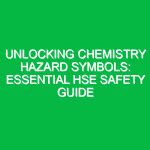Introduction
Chemical hazard signs are critical visual indicators that communicate the presence of hazardous materials in various environments, particularly in workplaces that handle chemicals. Their relevance in the Health, Safety, and Environment (HSE) domain cannot be overstated. These signs serve as a first line of defense, alerting employees and visitors to potential dangers and guiding them on how to act safely. By understanding and adhering to these signs, we can significantly reduce the risk of accidents, injuries, and environmental harm.
In this article, we will explore the key aspects of chemical hazard signs, their importance in promoting Safety, the Regulations that govern their use, and Best Practices for implementation. We will delve into real-life scenarios and case studies to illustrate the impact these signs have on Workplace Safety and environmental protection.
Understanding Chemical Hazard Signs
Chemical hazard signs are designed to inform individuals about specific Hazards associated with chemicals. These signs typically include symbols and colors that convey information quickly and effectively. Recognizing these signs is essential for anyone working with or around hazardous materials.
Components of Chemical Hazard Signs
Chemical hazard signs generally consist of several components:
- Symbol: Often a pictogram representing the type of hazard (e.g., a skull for toxicity).
- Signal Word: Words like “Danger” or “Warning” indicate the severity of the hazard.
- Hazard Statement: A brief description of the nature of the hazard.
- Precautionary Statement: Guidance on safe handling, storage, or disposal.
Understanding these components is vital for interpreting the signs correctly and taking appropriate Safety Measures.
Types of Chemical Hazard Signs
Various types of chemical hazard signs exist, each indicating different types of Hazards. The Globally Harmonized System of Classification and Labelling of Chemicals (GHS) provides a standardized approach, which includes:
- Flammable: Indicates materials that can easily ignite.
- Corrosive: Signifies substances that can cause destruction to living tissue or severe corrosion to materials.
- Toxic: Alerts to substances that can cause harm or death through exposure.
- Explosive: Represents materials that can explode under certain conditions.
- Environmental Hazard: Indicates substances that pose a threat to the environment.
Each type of sign is designed to provide immediate information that can influence Safety practices and emergency responses.
Importance of Chemical Hazard Signs in HSE
Chemical hazard signs play a pivotal role in promoting health, safety, and environmental Sustainability. Their importance includes:
Enhancing Safety Awareness
The primary purpose of chemical hazard signs is to enhance safety awareness among employees and visitors. By clearly marking areas where hazardous chemicals are present, these signs help individuals recognize potential risks. For instance, a simple flammable sign can alert workers to avoid open flames or sparks in areas where flammable liquids are stored.
Reducing Accidents and Injuries
Properly placed and maintained chemical hazard signs can significantly reduce accidents and injuries. According to the U.S. Bureau of Labor Statistics, workplaces that adhere to safety protocols, including the use of chemical hazard signs, experience fewer workplace injuries. For example, a manufacturing plant that implemented clear hazard signage reduced its accident rate by 30% over two years.
Compliance with Regulations
Chemical hazard signs are often mandated by various regulations and Standards, such as OSHA in the United States and REACH in the European Union. Compliance with these regulations not only protects workers but also helps organizations avoid legal repercussions. Understanding these regulations ensures that companies are held to a high standard of safety.
Environmental Protection
In addition to protecting human health, chemical hazard signs also serve an environmental purpose. By indicating the presence of hazardous substances, these signs help prevent spills and leaks that could harm the ecosystem. For instance, a chemical storage facility that uses appropriate hazard signage can prevent accidental releases of toxic substances into the environment, thus safeguarding local wildlife and water sources.
Best Practices for Implementing Chemical Hazard Signs
To maximize the effectiveness of chemical hazard signs, organizations should follow Best Practices for their implementation:
Regular Training and Education
Ensure that all employees are trained to recognize and interpret chemical hazard signs. Regular safety meetings can reinforce the importance of these signs and keep safety top of mind. For instance, a company may conduct quarterly training sessions that focus on understanding the significance of chemical hazard signs in the workplace.
Proper Placement of Signs
Place signs in visible locations, particularly at entry points to areas where hazardous materials are stored or used. The positioning of signs should allow for quick recognition from various angles and distances. For example, a factory could install large, illuminated signs above chemical storage areas to ensure visibility even in low-light conditions.
Routine Inspections and Maintenance
Conduct regular inspections to ensure that all chemical hazard signs are intact, legible, and free of obstructions. Signs that become faded or damaged should be replaced immediately to maintain clear communication about hazards. A manufacturing facility should implement a checklist for weekly inspections of safety signage as part of their overall safety management system.
Utilizing Technology
Consider using digital signage or augmented reality to enhance communication about chemical hazards. Digital displays can provide real-time updates on hazards, safety protocols, and emergency information. For example, a laboratory might use a digital screen to display current hazards and safety tips, ensuring that all personnel have access to the latest information.
Regulations and Standards Governing Chemical Hazard Signs
Understanding the regulations and standards that govern chemical hazard signs is crucial for compliance and safety. Several key bodies and regulations shape the landscape of chemical Hazard Communication:
osha (Occupational Safety and Health Administration)
In the United States, OSHA sets standards for chemical hazard communication through the Hazard Communication Standard (HCS). This standard requires employers to inform employees of the hazards associated with chemicals they may be exposed to at work. Chemical hazard signs are a vital part of this communication strategy.
GHS (Globally Harmonized System)
The GHS provides an internationally recognized framework for classifying and labeling chemicals. It promotes consistent hazard communication across borders, helping to ensure that workers worldwide can understand the risks associated with chemical exposure.
REACH (Registration, Evaluation, Authorisation, and Restriction of Chemicals)
In Europe, REACH regulates the production and use of chemical substances. This regulation includes requirements for labeling and safety data sheets, which often incorporate chemical hazard signs to ensure safe handling and use.
Conclusion
In summary, chemical hazard signs are essential tools for promoting health, safety, and environmental sustainability. They enhance safety awareness, reduce the risk of accidents, ensure compliance with regulations, and protect the environment from hazardous materials. By implementing best practices in training, placement, maintenance, and technology, organizations can maximize the effectiveness of these signs.
As industries continue to evolve, the importance of proper chemical hazard communication will only grow. Investing in education and resources related to chemical hazard signs not only protects workers but also fosters a culture of safety and responsibility. For anyone involved in handling hazardous materials, understanding and respecting these signs is paramount for ensuring a safe and healthy work environment.


